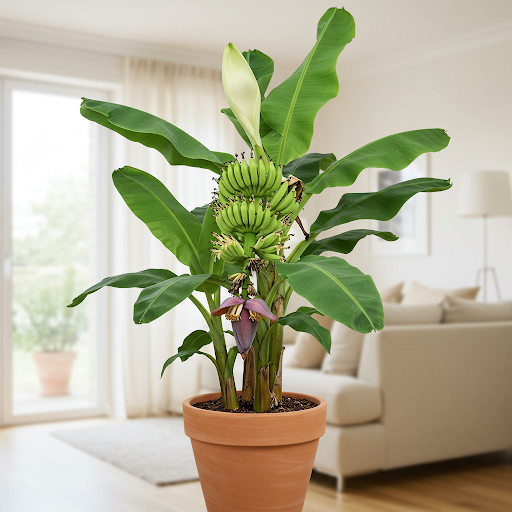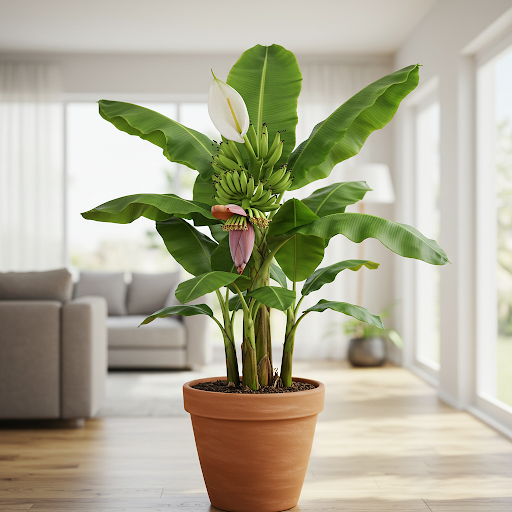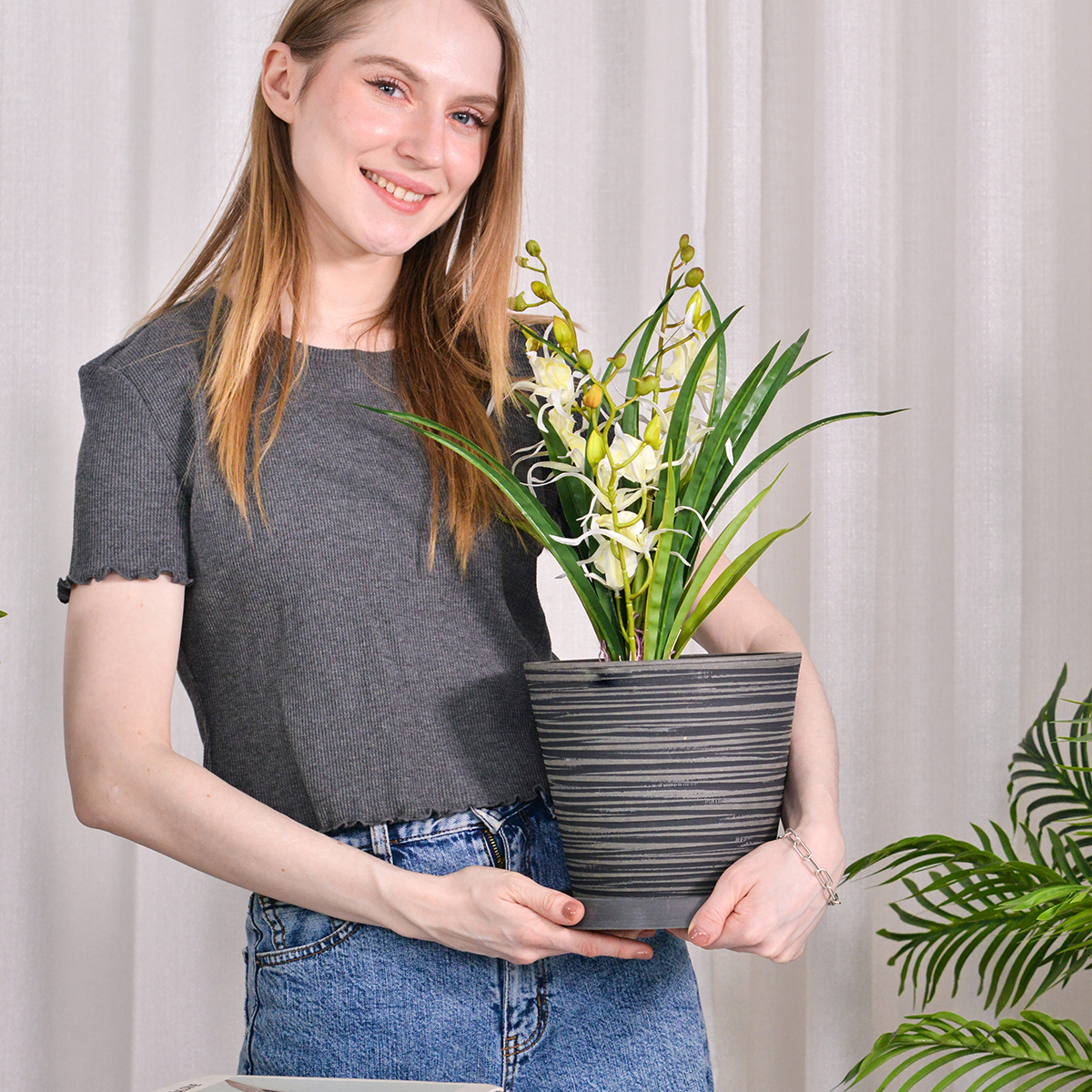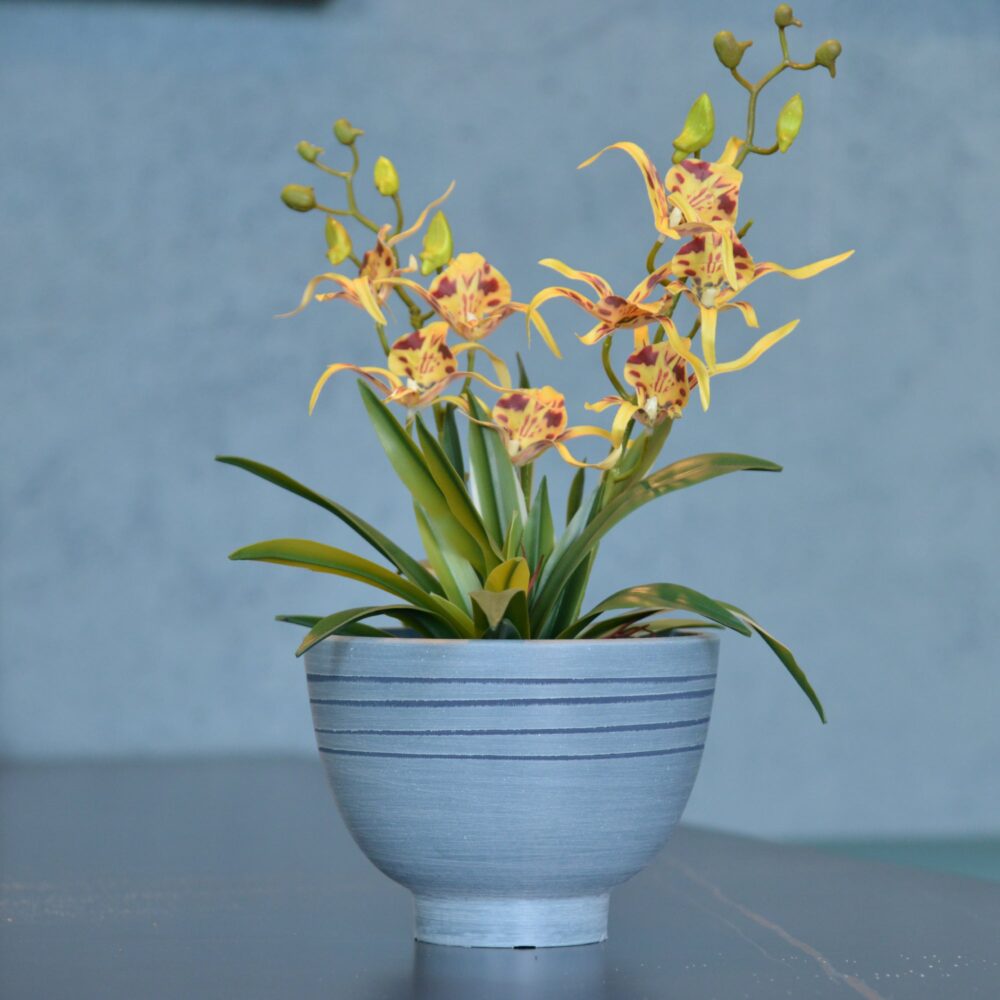Banana Plant Indoors: The Complete Guide to Growing Musa at Home
Longing for a touch of the tropics in your home with lush, vibrant foliage? Banana Plants, scientifically known as Musa, are fast-growing, impressive plants prized for their large, paddle-shaped leaves and tropical appearance. While known for their fruit in warmer climates, many Musa varieties are fantastic foliage houseplants that can thrive indoors. These relatively easy-to-grow plants, native to tropical regions of Southeast Asia, are perfect for adding a bold statement and a touch of exotic greenery to your indoor spaces. This comprehensive guide will provide you with everything you need to know to grow Musa indoors, from selecting the right variety and pot to mastering essential care techniques for a thriving and dramatically leafy Banana Plant in your home.

Banana Plants
What is Banana Plant (Musa)?
Musa is the genus of herbaceous flowering plants best known for the banana fruit. However, many Musa species and cultivars are grown ornamentally for their bold, tropical foliage. Banana plants are characterized by their large, elongated, paddle-shaped leaves that can be solid green, variegated, or even have reddish hues, depending on the variety. They grow from a central pseudostem (formed by tightly rolled leaf sheaths) and can reach impressive sizes even indoors, though indoor plants are typically smaller than their outdoor counterparts. While some indoor banana plants may flower and even fruit under ideal conditions, they are primarily grown as foliage plants in homes. Banana plants are prized for their dramatic, tropical appearance, rapid growth, and air-purifying qualities, making them a striking and rewarding houseplant.
Can Banana Plants (Musa) Thrive Indoors?
Yes, Banana Plants (Musa) can thrive indoors and are increasingly popular as houseplants, especially for those seeking large, statement greenery. While they are native to warm, humid tropical climates, many varieties are adaptable to indoor environments, provided they receive sufficient light, warmth, and humidity. Growing Banana Plants indoors allows you to enjoy their lush, tropical foliage year-round, adding a dramatic and exotic touch to your home décor. While fruiting indoors can be challenging and less reliable than outdoor cultivation, it is possible under optimal conditions, adding an extra element of novelty to indoor banana growing.
Ideal Indoor Growing Conditions for Banana Plants (Musa):
- Varieties of Banana Plant (Musa) for Indoors: While full-sized fruiting banana trees can become too large for typical homes, several dwarf and semi-dwarf varieties are well-suited for indoor growing. Popular indoor Banana Plant varieties include:
- *Musa acuminata ‘Dwarf Cavendish’: The most popular dwarf variety, reaching 4-8 feet tall, known for producing edible fruit (though less reliably indoors).
- *Musa ‘Truly Tiny’: A very compact dwarf, often staying under 3 feet, rarely fruits indoors, primarily grown for foliage.
- *Musa ‘Super Dwarf Cavendish’: Another very small variety, similar to ‘Truly Tiny’.
- *Musa velutina (Pink Velvet Banana): Ornamental banana grown for its fuzzy pink fruit (inedible) and attractive foliage, relatively small size.
- *Musa ornata (Flowering Banana): Ornamental banana grown for its showy pink to orange flowers and smaller size, fruit is not typically edible.
- *Musa basjoo (Hardy Banana): While technically hardy outdoors in some zones, it can be grown in a large container indoors, very cold-tolerant but can become quite large.
- Light: Banana Plants need bright light to thrive indoors. They need at least 6-8 hours of bright, indirect sunlight per day. South-facing windows are often ideal, but east or west-facing windows can also work if they provide several hours of direct morning or afternoon sun. Filtered light through sheer curtains is beneficial, especially in very sunny locations, to prevent leaf scorch. Insufficient light will result in slow growth, smaller leaves, and leggy stems. If natural light is insufficient, supplement with grow lights.
- Soil: Banana Plants need rich, well-draining soil that retains moisture. Use a high-quality potting mix that is rich in organic matter. You can use a general-purpose potting mix amended with compost, coco coir, and perlite or vermiculite to improve drainage, aeration, and moisture retention. Banana plants are heavy feeders and benefit from nutrient-rich soil.
- Watering: Banana Plants are thirsty plants and need consistent moisture, especially during the growing season (spring and summer). Water thoroughly when the top inch of soil begins to feel slightly dry. Water deeply until water drains out of the drainage holes. Allow the top inch of soil to dry out slightly between waterings, but do not let the soil dry out completely, especially during active growth. Reduce watering slightly in fall and winter when growth slows down, but still maintain some moisture. Banana plants are sensitive to both drought and soggy soil. Overwatering can lead to root rot, while underwatering can cause leaf curling and browning. Watering frequency will vary depending on light levels, temperature, humidity, pot size, and growth rate. Check soil moisture regularly. Use room temperature water.
- Temperature: Banana Plants thrive in warm temperatures, ideally between 65°F to 80°F (18°C to 27°C). They are tropical plants and prefer warm conditions year-round. Avoid exposing them to temperatures below 55°F (13°C) or sudden temperature fluctuations and cold drafts. They are not frost-tolerant.
- Humidity: Banana Plants thrive in high humidity, ideally 50% or higher. They are native to humid tropical environments and appreciate moist air. Dry air can lead to crispy leaf edges and slower growth. Increase humidity by:
- Misting Regularly: Mist the foliage frequently with room temperature water, especially in drier indoor environments or during winter heating.
- Pebble Trays: Place pots on trays filled with pebbles and water (water level below the pot base).
- Humidifier: Use a room humidifier, especially during dry seasons or winter heating.
- Grouping Plants: Grouping Banana Plants with other humidity-loving plants can create a more humid microclimate.
- Warm, Humid Bathrooms (if suitable light): A well-lit bathroom can be a suitable location due to naturally higher humidity.
Planting Your Banana Plant (Musa) Indoors:
- Starting from Rhizome, Suckers, or Potted Plants: Banana Plants are most commonly started from rhizomes (underground stems), suckers (offsets from the base of the plant), or purchased as established potted plants. Potted plants are the easiest way to start growing Banana Plants indoors. Purchase from nurseries, garden centers, or online retailers specializing in tropical plants.
- Propagation from Suckers: Suckers can be carefully separated from the parent plant and potted up. Rhizomes can also be divided and planted.
- Planting Time: Banana Plants can be planted or repotted at any time of year indoors, but spring or early summer, at the start of the growing season, is generally recommended for optimal establishment and growth.
Choosing the Right Pots for Indoor Banana Plants (Musa):
- Suitable Pot Types: Select large, sturdy pots with good drainage. Terracotta pots, ceramic pots, or durable plastic pots are all suitable. Due to their rapid growth and potential size, choose strong, stable pots that can support the plant’s weight.
- Drainage: Drainage is essential for Banana Plants to prevent root rot. Ensure your chosen pot has large drainage holes at the bottom. You can also add a thick layer of gravel or pot shards at the base of the pot to improve drainage significantly.
- Pot Size: Choose a pot that is appropriately sized for the current size of the plant and allows for substantial growth. Banana Plants are fast growers and will need repotting into larger containers as they mature. Start with a pot that is 2-4 inches larger in diameter than the root ball when repotting. Young plants can start in 8-10 inch pots. Mature indoor Banana Plants, especially dwarf varieties, may eventually need pots that are 14-24 inches in diameter or larger to accommodate their root system and growth. Choose the largest pot you can reasonably accommodate indoors, as larger pots retain moisture longer and provide more room for root development.
- Potting Mix: Use a rich, well-draining potting mix as described earlier (general-purpose mix amended with compost, coco coir, and perlite/vermiculite).
Essential Care Tips for a Thriving Indoor Banana Plant (Musa):
- Watering Schedule: “Water Generously, Allow Top Inch to Slightly Dry”. Water thoroughly when the top inch of soil is slightly dry, especially during the growing season. Allow topsoil to slightly dry between waterings. Avoid overwatering and soggy soil, but also prevent complete dryness.
- Light Management: Bright Light is Essential. Provide bright, indirect to direct light for optimal growth. At least 6-8 hours of bright light daily.
- Humidity is Crucial: Maintain high humidity for healthy foliage and prevent crispy edges. Misting, pebble trays, or humidifiers are very beneficial, especially in dry indoor air.
- Fertilizing: Heavy Feeding During Growing Season. Banana Plants are heavy feeders and require regular fertilization during the growing season (spring and summer) to support their rapid growth and large foliage. Fertilize every 2-4 weeks during the growing season with a balanced liquid fertilizer (20-20-20 or similar) diluted to half strength, or a fertilizer specifically formulated for tropical plants or foliage plants. Follow package instructions carefully. You can also supplement with slow-release fertilizer granules or organic fertilizers like compost tea or well-rotted manure. Reduce or stop fertilizing during the fall and winter dormant period.
- Pruning (Mainly for Leaf Maintenance): Pruning is mainly for removing dead, damaged, or yellowing leaves to maintain a tidy appearance. You can also trim off lower leaves as the plant grows taller to encourage an upright form. Avoid heavy pruning of the main stem, as this can slow growth.
- Repotting Schedule: Repot Banana Plants every 1-2 years, or when they become root-bound or outgrow their current container. Repot in spring or early summer. Repotting into a larger container with fresh potting mix is essential to accommodate their rapid growth and nutrient needs.
- Support (May be Needed for Tall Varieties): Taller banana varieties may become top-heavy or require support, especially if they produce fruit indoors. Provide support with stakes or bamboo poles if needed to keep stems upright and prevent them from bending or breaking.
- Flowering and Fruiting (Indoors, Possible but not Guaranteed): Indoor Banana Plants may flower and potentially fruit under ideal conditions (mature plant, bright light, warmth, humidity, fertilization). However, fruiting indoors is not guaranteed and may take several years. Hand-pollination may be necessary to encourage fruit set indoors. Even if they don’t fruit, they are still stunning foliage plants.
- Pest and Disease Control: Monitor Banana Plants for pests like spider mites, aphids, mealybugs, and scale insects. Banana plants are relatively resistant to serious diseases when grown indoors with proper care. Root rot can occur if overwatered. Ensure good drainage and avoid overwatering to prevent root rot and fungal issues. Treat any pest infestations promptly with insecticidal soap or neem oil.
Popular Banana Plant Forms (within Musa):
- *Musa acuminata ‘Dwarf Cavendish’ (Dwarf Fruiting Banana)
- *Musa ‘Truly Tiny’ (Miniature Banana)
- *Musa velutina (Pink Velvet Banana)
- *Musa ornata (Flowering Banana)
- *Musa basjoo (Hardy Banana – for very large indoor spaces)
- Numerous other Musa species and hybrids are available, explore local nurseries for unique foliage types.
In Summary:
Growing Banana Plants (Musa) indoors is a rewarding way to bring a dramatic, tropical flair and lush greenery to your home. Their bold foliage and rapid growth make them captivating and statement-making houseplants. By providing bright light, rich, well-draining potting mix in large pots with drainage, watering generously and consistently, maintaining high humidity, and providing regular fertilization during the growing season, you can easily cultivate thriving and impressive Banana Plants indoors and enjoy their exotic presence year after year.

Banana Plants
For more detailed botanical information and to explore the diversity of the Musa genus, you can visit the Wikipedia page on Musa.
Important Note: Banana Plants (Musa) are considered non-toxic to humans and pets, making them a safe choice for households with children and animals. However, it’s always best to keep houseplants out of reach of pets and children who may be tempted to chew on leaves. The primary care considerations with Banana Plants are providing sufficient light, water, humidity, and space for their rapid growth. With attention to these needs, you can successfully grow these impressive plants indoors and create your own indoor tropical oasis.**
K2-11T
By greenship|2024-08-13T04:21:25+00:00August 13, 2024|Categories: Hand-carving Series|
KC3-14A
By greenship|2024-08-16T06:26:30+00:00August 16, 2024|Categories: Hand-carving Series|
Planter 6 in W / 8 in W / 12 in W Indoor or Outdoor Plants, Modern Decorative Plant Pots with Drainage Hole, Decorative Flower Pots
By greenship-seo|2025-02-06T13:43:53+00:00January 16, 2025|Categories: Hand-carving Series|Tags: Decorative Flower Pots|
k2-21G
By greenship|2024-08-13T06:17:26+00:00August 13, 2024|Categories: Hand-carving Series|
8 inch/10 inch Planter Indoor Plants, 2 Pack Modern Decorative Plant Pots with Drainage Hole, Cute Bowl Shape Flower Pots
By greenship-seo|2025-04-10T08:03:42+00:00January 9, 2025|Categories: Hand-carving Series|Tags: Decorative Flower Pots, Self-Watering Pots|
11TH
By greenship|2024-08-13T02:50:25+00:00August 13, 2024|Categories: Hand-carving Series|






